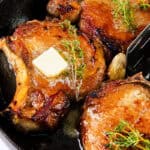Pan Seared Brined Pork Chops
Crispy on the outside, these juicy Pan Seared Pork Chops are simple to make and perfect every time.
Servings 4
Calories 408
Ingredients
For The Brine
- 4 cups water at room temperature
- 1 teaspoon baking soda
- ¼ cup kosher salt
- 1 tablespoon peppercorns
- ¼ cup packed light or dark brown sugar
- 4 pork chops at least1½ inches/4cm thick, 8oz/227g each
For Searing
- 2 tablespoons olive oil
- 4 garlic cloves whole, unpeeled
- 4 sprigs fresh thyme whole (plus more if desired)
- 2 tablespoons butter
Instructions
For The Brine
- Place the water, baking soda, salt, peppercorns, and brown sugar in a large bowl and stir to dissolve the salt and sugar. Add the pork chops, cover the bowl with plastic wrap and refrigerate for 1 to 8 hours.
To Sear
- Remove the pork chops from the brine 20-30 minutes before you plan to cook them, and pat the chops dry with paper towels.
- If the pork chops have a layer of fat, score the fat layer with a knife making the cuts about 2 inches apart.
- Add the oil to the pan and preheat the pan over high heat until the oil shimmers and starts to smoke slightly.
- Once the oil is hot, reduce the heat to medium and add the garlic cloves and pork chops to the pan. Cook undisturbed for 3 minutes (they should be golden brown).
- Flip pork chops to the uncooked side down and cook another 2 minutes to brown. Keep turning chops every 2 minutes until both sides are deep golden brown and they reach 135 to 140°F/57 to 63°C in the thickest part.
- If the fat is thick and hasn't cooked down, pick up the pork chop with tongs and hold the pork chop upright, with the fatty edge on the pan. Cook until the fatty edge get's crisp and brown, about 2 minutes.
- Once the pork chops reach an internal temperature of 135 to 140°F/57 to 63°C, remove from the heat top with ½ Tablespoon of butter and a sprig of thyme, allow to melt, and spread the butter over the chops.
- Transfer the chops to a dish, cover loosely with foil, and allow to rest until they reach an internal temperature of 150 to 155°F/66 to 68°C for medium doneness before serving.
Notes
I highly recommend reading the post above in detail, as there is a ton of useful information to help you to make this recipe successfully!
The instructions above are for medium doneness, which is juicy meat with a hint of pink. Please see the table in the post for other doneness levels and internal temperatures. Or click here for a free printable.
Tips
- The baking soda may cause your chops to feel slippery when you remove them from the brine. This is completely normal.
- Dry the meat thoroughly before cooking for the best possible sear.
- Cook in batches – If your pan isn’t large enough to allow about two inches between the chops, don’t try to brown them in a single batch (even if you think they’ll fit). I cook the chops in batches of two as I find four in the same pan lowers the heat of the pan, causing the meat to steam rather than brown. Take the extra few minutes to sear the chops in two batches.
- Using a meat thermometer guarantees your pork chops are cooked thoroughly and also helps avoid overcooking them and them being tough. I highly recommend you use a meat thermometer.
- If the fat is thick and hasn’t cooked down, pick up the pork chop with tongs, and hold the pork chop upright, with the fatty edge of the pan. Cook until the fatty edge get’s crisp and brown, about 2 minutes.
- Make sure the chops are well and evenly browned on both sides, and use a large enough pan, so they are not crowded while browning.
Nutrition
Calories: 408 | Carbohydrates: 16g | Protein: 29g | Fat: 25g | Saturated Fat: 10g | Polyunsaturated Fat: 2g | Monounsaturated Fat: 11g | Trans Fat: 1g | Cholesterol: 112mg | Sodium: 14291mg | Potassium: 569mg | Fiber: 1g | Sugar: 13g | Vitamin A: 282IU | Vitamin C: 1mg | Calcium: 49mg | Iron: 1mg
